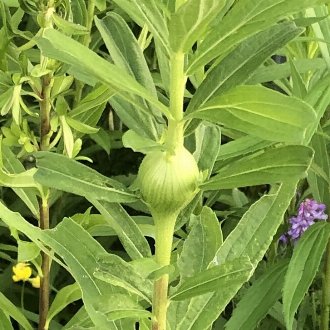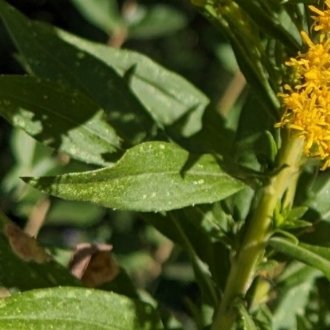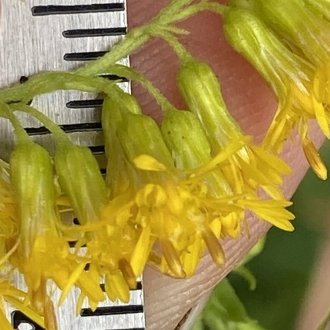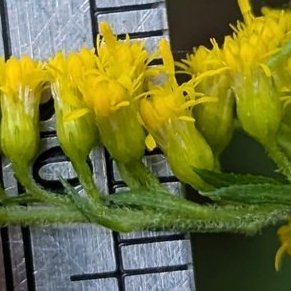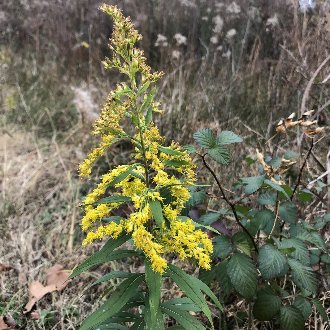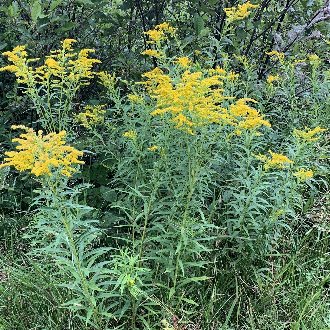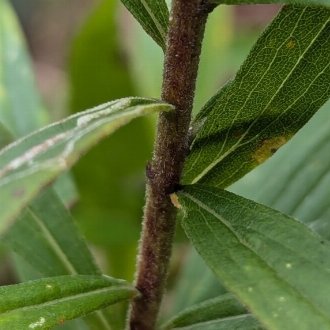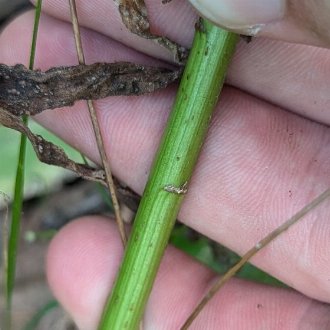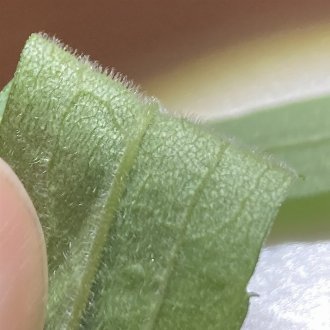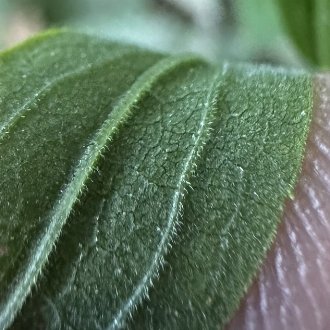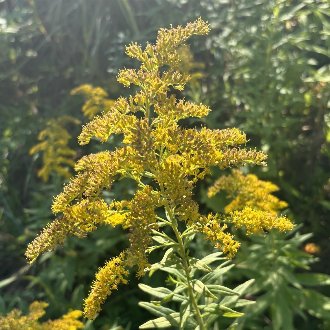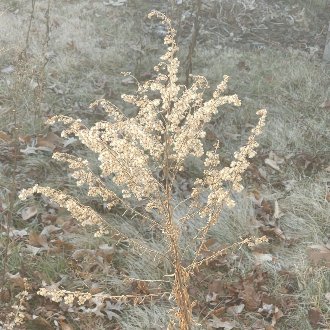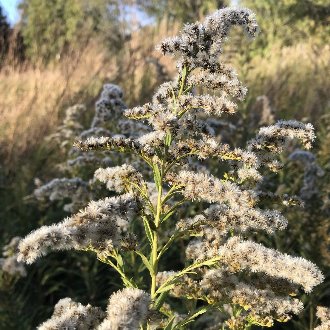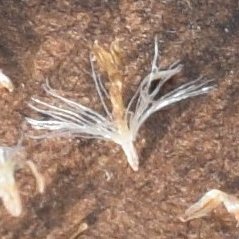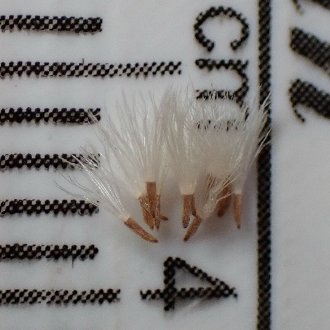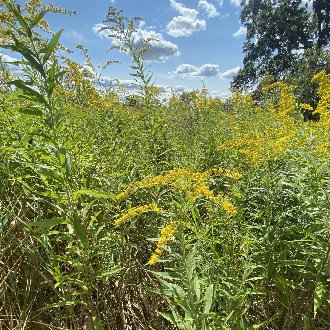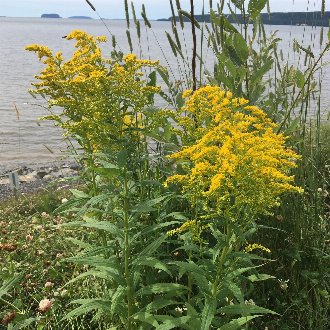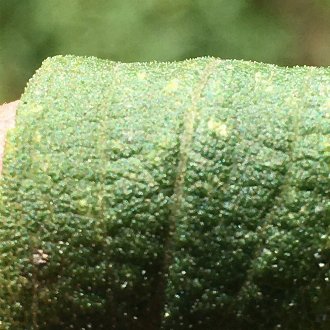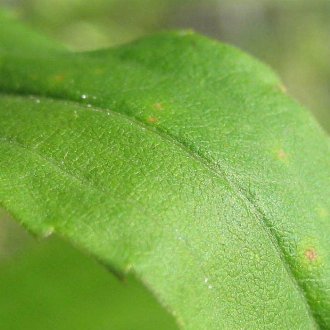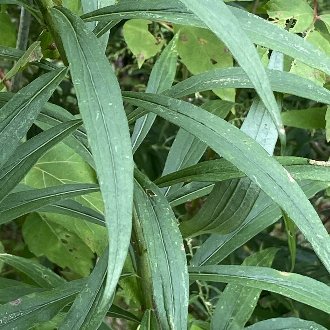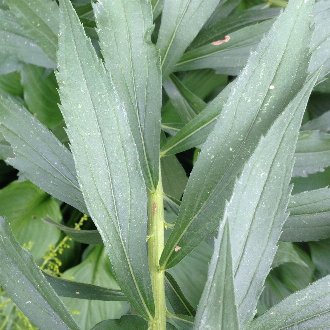Tall Goldenrod vs Canada Goldenrod
These two goldenrods are challenging to tell apart where their ranges overlap. Both are tall, rhizomatous, grow in sunny habitats, and have triple-nerved leaves and large inflorescences. They can be distinguished by degree of serration on upper leaves, and by involucre and pappus length. Ball galls on the stem identify some plants as S. altissima. There are average differences in inflorescence shape, bloom time, and pubescence on leaves and stems. S. altissima ranges much farther south and west, and tolerates drier conditions. S. canadensis ranges farther north, prefers moister conditions, and is slightly more shade-tolerant. Inconsistent taxonomic treatments complicates ID.
Tall Goldenrod (Solidago altissima) | Canada Goldenrod (Solidago canadensis) |
A common, aggressive perennial of rich, sunny, disturbed sites, native to a wide range across North America. | A robust, rhizomatous perennial primarily native to the northeast, preferring sunny, mesic to moist sites. |
Stems may have large, conspicuous ball galls on them. Photo © Andrew Sebastian, CC BY 4.0. | Stems almost never have ball galls. Photo © Darius Regnier, Public Domain. |
Leaves average less conspicuously serrated. Leaves directly under the inflorescence may have no teeth, or only very subtle teeth. Photo © ncb1221, CC BY 4.0. | Leaves average more conspicuously serrated. Leaves directly under the inflorescence have prominent teeth. Leaves in the inflorescence may lack teeth. Photo © Étienne Lacroix-Carignan, Public Domain. |
Involucres (clusters of bracts under each flowerhead) are longer (2.5–4.5mm) and tend to look narrower. Length measurement is more consistent than shape. Photo © Derek, CC BY 4.0. | Involucres are shorter (1.7-2.5mm, rarely to 3mm) and tend to look more stout. Length measurement is more consistent than shape. Photo © Ryan Sorrells, CC BY 4.0. |
Usually blooms later (Mid-to-Late Aug-Nov, peaking Sep-Early Oct) Often is among the last plants blooming. (Photo from December in NC.) Photo © Ken Kneidel, Public Domain. | Usually blooms earlier (Late July-Early Oct, peaking Aug-Sep). (Photo from August, PEI, Canada) Photo © scaup, CC BY 4.0. |
Lower portion of the stem averages more hairy. Stem is usually hairy the whole way to the base, only occasionally nearly smooth. Photo © Skyler Principe, CC BY 4.0. | Lower portion of the stem averages less hairy, and is more likely to be nearly smooth. Photo © Ryan Sorrells, CC BY 4.0. |
Leaf underside has more hair along veins, but still has some hair throughout. As a result, leaf undersides often look slightly paler. Photo © Derek, CC BY 4.0. | Leaf underside usually only has hair along the veins. As a result, leaf undersides often look slightly deeper green. Photo © jyoung2399, CC BY 4.0. |
Inflorescences average slightly smaller and more compact, with a more pyramidal shape. Some inflorescences are as much as 2 times as tall as they are wide. Branches of the inflorescence are more likely to be ascending. Photo © Liszak Kristály, CC BY 4.0. | Inflorescences average slightly larger, and are wider-spreading and more open. Photo © rboles, CC BY 4.0. |
Especially in winter, inflorescence branches tend to curve back more at the tips, often creating a hook shape. Branches are straighter at the base where they meet the main stem. Photo © Alex Zorach, CC BY 4.0. | Inflorescence branches tend to curve back more at the base, and are less likely to form a hook-like shape by curving sharply at the tips. Photo © Robb Hannawacker, Public Domain. |
Seeds are more variable in length, sometimes shorter (0.5–1.5 mm) and often hairier, but not as ridged; pappi (wispy parts attached to seeds) are longer (2.5–3.5mm) Photo © Alex Zorach, CC BY-SA 4.0. | Seeds are consistently longer (1–1.5 mm) and average less densely hairy, but with a more distinct ridged look; pappi are shorter (1.8–2.2mm) Photo © Darius Regnier, Public Domain. |
Prefers drier habitats. Photo © botany08, CC BY 4.0. | Prefers wetter habitats. Photo © Rob Foster, CC BY 4.0. |
Adaxial (upper) leaf surfaces are consistently rough to the touch. Leaf color averages slightly paler. Photo © Becky Dill, Public Domain. | Adaxial (upper) leaf surfaces are either hairless and smooth, or only slightly rough to the touch. Leaf color averages a deeper, darker green. Photo © rboles, CC BY 4.0. |
Although average leaf dimensions are similar, leaf width is less variable, and leaves are usually at most 2cm wide (about 0.8 inches.) Photo © Sandy Wolkenberg, CC BY 4.0. | Although average leaf dimensions are similar, leaf width is more variable, and leaves on some plants may be up to 3cm wide (1.18 inches.) Photo © Matt Schultz, Public Domain. |
Additional Notes
WARNING About Taxonomy!!!
Different authorities use wildly different classification schemes for the Solidago genus. Many older authorities lump S. altissima in with S. canadensis as a subspecies or variety. These authorities usually consider the taxa we consider to be sub-taxa of S. altissima to be sub-taxa of S. canadensis instead. Even among authorities that separate the two species, however, there can be differences in treatments of various populations or sub-taxa.The inconsistent taxonomy has complicated ID because there are a large number of specimens we would call S. altissima which have been filed in herbaria and/or published on websites under the name S. canadensis, particularly in the southeast and central US. Herbaria are inconsistent in how they label or categorize such specimens. In the West, there are also other species which were previously treated as sub-taxa of S. canadensis, including western goldenrod (Solidago lepida), and in the southwest, threenerve goldenrod (Solidago velutina), further complicating matters. The labeling of these specimens has in turn affected the criteria people use to generate keys, ID guides, and range maps, producing some puzzling results such as how POWO (erroneously) reports S. canadensis native to the southwest in spite of treating S. velutina separately.
Some Tricky Points About Traits Used for ID
Some characteristics used to distinguish S. canadensis and S. altissima are highly variable at different points on the plant. For example, on both species, leaf serrations tend to be deeper and more pronounced on leaves at the base of the stem, and become progressively more subtle as one examines leaves higher up on the stem. Both species can have entire (unserrated) leaves in the inflorescence. And the difference between serrations tends to be more pronounced between the leaves at the bottom and tops of a particular plant, than they are between one species and the other. As such, in order to use this trait for ID, one must compare the leaves at the same point on each plant. A similar pattern plays out with stem pubescence: both species have a stem that becomes more pubescent higher up. However in this case, the variation between the two species is greater at the base of the stem, whereas the level of pubescence at the top of the stem is not useful for ID.An exception to this pattern is leaf width, which is more variable on S. canadensis both on narrower and wider ends, but stays more consistently within a narrow range on S. altissima.
Of the characteristics we cite above, involucre length and degree of serration on leaves around the stem's midpoint, seem to be the most reliable traits for distinguishing these species. The degree of pubescence is variable on both species, as is bloom time, and as such these traits may only be sufficient for ID in extreme cases. Bloom time is particularly unreliable on the late end, as individuals of S. canadensis may bloom late if they resprout after being top-killed during mid-summer, late enough to set back the bloom time but early enough that the plant still has enough time to bloom.
Some of the overlap is asymmetrical. In general, because S. altissima has a larger range and is abundant in much of its range, it tends to have more variability in most traits. Inflorescence shape is highly variable on both species, but is relatively more variable on S. altissima and more consistent on S. canadensis. A compact pyramidal inflorescence with strongly ascending branches that are straight near where they meet the stem, points more strongly to S. altissima, whereas when observing a more sparse, open inflorescence with branches gently recurved at the base, even if such a shape is more typical for S. canadensis, one cannot exclude S. altissima; see this photo for an example of such an individual.
Also consider other species, particularly, giant goldenrod (Solidago gigantea), which both of these species are easily confused with. In Canada and the Western US, also consider western goldenrod (Solidago lepida).
References & External Resources
These short lists show only links helpful for ID. For a complete list of references and resources also covering other aspects of ecology, visit the links section of the full article on each plant, which is the first entry here.



